Trip To The Spa
It's not all mud packs and mineral water, but for horses who need
rehabilitative therapy after surgery or an injury, a stint at the
spa may be just what's required to speed recovery and get the athlete
back to the training or show pen.
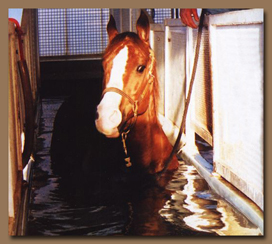
by Stephanie Stephens
Your horse's surgery was successful. Or maybe you've just been
handed the unwanted diagnosis of your prized competitor's injured
tendon or ligament. Now you're facing a period of recovery that
is critical to the process of bringing your horse back to 100 percent.
In a perfect world, you'd send your horse off to the equine equivalent
of the human Golden Door Spa... where he'd luxuriate in relaxation,
restoration and rehabil¬itation. Does such a place really exist?
Absolutely. Several, in fact. These facilities are as in tune with
your horse's medical needs as they are with ensuring that he has
a pleasant, positive experience while he's recuperating. Most include
a standard menu of services along with board. But it's also important
to ask each about additional therapy options that cost extra.
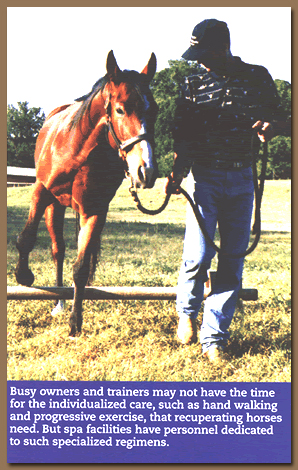
STANDING NOT RECOMMENDED
Although the words rehabilitation and aftercare have been used
frequently in the world of running Quarter Horses and Thoroughbreds,
these processes have been slow to forge their way into the dialogues
of western performance horse owners.
"Veterinarians whose practices see a predominance of reiners,
cutters and reined cow horses are now starting to think about using
our services more," affirms Daniel Vernay at the Selway Equine
Therapy Center in Whitesboro, Texas. He treats a majority of soft-tissue
injuries to tendons and ligaments, as well as post-chip-removal
arthroscopic surgeries.
Vernay can board up to 40 horses, whose usual stay at the "lodge"
is between 30 and 45 days. He'll frequently use the Aqua Tred, and
underwater treadmill, to help heal the injury. The exercise stretches
and flexes the affected area without straining it excessively. "The
horse can go through the full range of motion, but without handling
his full weight," Vernay points out.
The animal graduates to the power walk, "the edge of trotting,"
as the horseman describes it; trotting is not recommended. "Trotting
in deep water is not comfortable, and splashing can get the horses
excited, defeating the purpose of the therapy," Vernay explains.
"This has to be a controlled exercise, and with this machine,
we control the time, speed and more."
A horse's regimen is usually six days on the program, one day off.
This rehab specialist also incorporates use of the Eurociser walker-horses
work between panels instead of hooked to a chain, which enables
free exercise. "Then, after a few weeks, when we're comfortable
with the healing process, we might work them on a hard surface a
bit... walking, then jogging to increase the challenge to the tissue,"
Vernay explains.
Another high-tech tool found at Selway is the Electro-Acuscope.
Electrical stimulation to cells increases their metabolism, according
to Vernay, which, in turn, encourages blood flow to the injury location,
thus speeding healing.
The whole curriculum is about "helping the body of the horse
heal itself; it's a normal process of the body to heal damaged tissue,"
says Vernay
He counsels that standing in a stall is not the best thing for a
recouping equine. Why? He cites the example of "fibers aligning
themselves to go any which way - cross linking -creating a lot of
scar tissue. When the horse is working, you help the body align
the fibers with flexing and stretching, having good blood flow,
cleaning the injured spot of waste products that are creating scar
tissue, and then helping the body get rid of those."
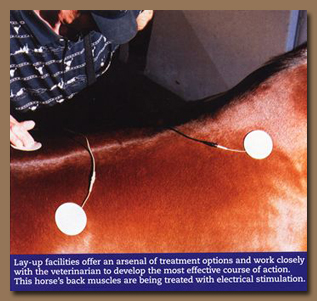
VETERINAY SUPERVISION
Vernay will also incorporate laser therapy, which uses light to
stimulate cells, thereby increasing metabolism. Therapeutic ultrasound
might be appropriate as well. "You can go a bit deeper and
send heat to the injured spot to promote blood flow, which also
has an effect on alignment of fibers in tendons and ligaments,"
he explains.
If requested, the facility will invite equine chiropractors and
massage therapists. He'll frequently recommend therapeutic shoeing
"to relieve some of the pressure or tension."
Vernay, a certified veterinary technician with experience at several
of the nation's most respected equine practices, works in tandem
with the attending veterinarian He'll bring home the ultrasound
of the injury, then stay in touch with owner and doctor as the horse
progresses.
"The vet is the guy with the know-how to tell us how bad or
good we're doing," Vernay says. "So, if there's a lesion
in the tendon, for example, I know exactly what happened due to
the very objective diagnostic."
He's a big fan of ice after exercise because any inflammation creates
waste and byproducts that are very bad for tissues. After 30 days,
another ultrasound is recommended, and if all's well, the horse
goes home and back to training. If not, it's back to another two
to three weeks of rehab.
Dr. Chris Ray of nearby Weatherford, Texas, frequently discharges
his equine patients to Vernay's care. "It's been an area in
which we've been lacking," says Ray of post-injury or surgical
care, "and one in which we have the greatest room for improvement."
As he does his share of chip removal from knees and ankles and treats
suspensory problems, he's a big fan of the fitness benefits derived
from a program such as Vernay's. After all, when the horse is well,
it's back to work.
He finds himself recommending rehab with increasing frequency. "I
had no takers at first, but now word of mouth has spread the news.
When my job is done, it's going to take time to get the horse back
where he started."
Although more research is needed into the best ways to speed recovery,
Dr. Ray maintains that "motion in moderation" and "decreasing
weight-bearing" does help. "If a horse just stands, the
joints stiffen," he says. "Daniel's plan encourages a
return to health of the soft tissues, and it means an owner doesn't
have to start from square one when the horse comes home."
Vernay, meanwhile, doesn't purport to be a miracle-worker. But he
does love to see great results, which occur often. He admits, however,
"I don't claim to cure everything."
You're wondering about cost: Expect to pay approximately $1,000-$1,500
a month for your horse to rehab with Vernay. "Two thousand
would be a maximum," he calculates.
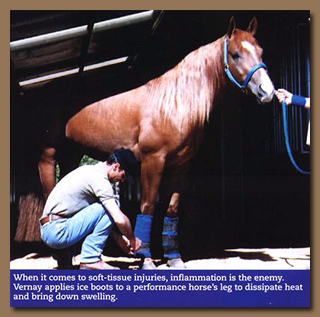
PAIN STOPS WORK
"The only thing that stops a performance horse from doing
his job is pain," says Kirstin Johnson of Kentucky Equine Sports
Medicine and Rehabilitation Center (KESMARC) in Versailles, Kentucky.
"He doesn't just wake up and say, I don't want to stop and
turn today.'"
On a typical day, Johnson is hosting three world champion Quarter
Horses in her barn in addition to some of the most prized Thoroughbred
racehorses in the country, some of which cost or are insured for
millions of dollars.
Johnson isn't shy about touting her comprehensive range of services.
"We have created what we believe to be the most complete and
innovative sports medicine and rehabilitation center for horses
in the world," she attests.
One look at the offerings and it's difficult to challenge her. First,
there's the swimming pool, "providing all of the benefits of
on track conditioning without stressing the tendons, ligaments and
muscles of the legs. It maintains muscle tone and cardiopulmonary
capacity. It's excellent therapy for muscle atrophy and neuropathy."
She's also a vocal proponent of using the AquaTred. "Remove
those spurs, take the sutures out, and immediately go to the AquaTred,"
she recommends. "It's also great after colic surgery, with
the water supporting the stomach. It keeps horses fresher. Mentally,
they think it's fun and enjoy the reward system. It may be the most
perfect type of conditioning for the equine athlete. It maintains
and enhances conditioning in a relatively stress-free environment,
with 20 Jacuzzi jets (five on each leg) and a controlled water temperature."
At her facility, a horse that's had hock surgery might spend a period
of 45-60 days rehabbing with the help of not only the underwater
treadmill, but the EquiGym walking machine as well.
The latter, says Johnson, "provides the ability to work in
both directions, insuring balanced, uniform development of the cardiovascular,
respiratory and musculoskeletal system with controlled intensity,
duration and fre¬quency of exercise."
KESMARC employs a hyperbaric, or high-pressure, oxygen chamber too.
"The oxygen given with increased pressure can correct many
serious health problems," Kirstin explains. "The oxygen
is no different than natural oxygen, as the increased pressure does
not change the composition. It does, however, allow the oxygen to
get into the tis¬sues more quickly and in greater amounts."
Horses have access to indoor and outdoor jogging/training tracks,
turnout paddocks, a solarium for sun soaking benefits, and, if requested,
a range of services including chiropractic and massage.
Without naming names, Johnson cites a reining horse "that won
the limited open ten days off our farm. He'd had a stifle strain.
This program gives horses like him the option to stay fit without
pounding them. The horses have a solid foundation of training already.
That's not what they need; lack of pain is what's necessary to allow
them to do the job they're trained to do."
Johnson's daily board, including time in the Aquatred and necessary
services. Expect to pay $400 for hyperbaric treatments.
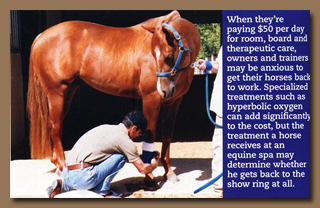
ALL IN ONE PLACE
Both Vernay's and Johnson's rehab centers provide the ultimate
environment for a horse to go after leaving the veterinarian. At
Alamo Pintado Equine Medical Center in the Santa Ynez Valley of
California, Doug Herthel, DVM, incorporates hospital and rehab *into
one comprehensive facility.
"We see mostly soft-tissue injuries in reiners, cutters and
cow horses," confirms Herthel, "and it's the magnitude
of the injury that determines the length of rest period and rehabilitation."
Gradations range from stall rest, perhaps with hand walking, to
complete immobilization - putting the leg in a cast or splint. "We
have no set program for every type of injury, because we want to
customize to horse and owner," Herthel says. Of course, hand
walking may be impossible with some hotter horses, he admits.
Along with the Aquatred, Herthel vigorously champions the effectiveness
of the hyperbaric oxygen chamber in conjunction with stem cell therapy.
"Suspensory injuries are common when a horse works on deep
footing without a proper bottom," explains the doctor. "The
ground should 'bounce' the foot back; when the footings too deep,
the foot keeps sinking down, and the horse can injure the ligament."
He'll first diagnose the lesion with ultrasound, then treat the
horse with its own stem cells and bone marrows "to regenerate
that ligament." The cost for this treatment is $1,200-$ 1,500.
Then the equine is placed in the hyperbaric chamber for two to three
treatments at approximately $400 a treatment. And the horse's board
and daily care cost $50 a day on top of that.
But the expense is well worth it, says Herthel, who designates the
stem cell/chamber combo as "the Cadillac of treatments"
for tendon issues.
"We use the chamber routinely not only for treating injuries
and traumas, but also for infections of the skin or muscle,"
he says. "It has the ability to enhance the effect of antibiotics
with high-dose oxygen administered in three atmospheres of pressure."
Herthel wants to stop the enzymatic breakdown of the ligament after
an acute injury. "Oxygen does that, and it gets rid of edema,
or swelling," he points out.
Then the horse undergoes stall rest for one to two weeks and handwalking,
if possible, for 30-60 days, 30 minutes a day. The Aquatred may
also be used, but "different modalities are employed depending
upon the condition of the injury.:
Herthel once used infrared lasers, magnets and more before he began
using the stem cell procedure in 1995. But "the bad suspensories
were coming back and weren't staying sound," he recalls. Now
he sees up to an 85 percent success rate with stem cell administration.
Herthel also calls into play the role of nutrition when rehabbing
a horse. Now, if you're thinking "spa menu," it's not
that at all, but rather "therapeutically providing the amounts
of Omega 3 that horses need for tissue healing. The substance contributes
to the health of the tissue and decreases inflammation."
If you don't live in the neighborhood, obviously, you'll need to
arrange shipping for your horse to an appropriate facility. But,
if the ultimate outcome is important to you, then the extra trouble
and expense is probably worth it.
Do-it-yourself works fine in many scenarios, but equine rehab may
not always be one of them, especially when the career of a money-winning
performer is on the line. Aren't we horse owners lucky that innovation
continues to bring us so many beneficial options for our cherished
animal partners?
-return to article list-
|